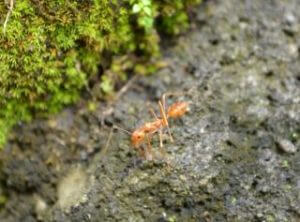Citronella Ants
Quick Stats
- Latin Name: Lasius interjectus
- Size: Workers average around 4mm long while queens can measure from 8-10mm long.
- Color: Yellow from head to hindquarters.
- Shape: These ants are even in size throughout all three parts of their body. The swarmers have large, dark-colored wings.
- Found in: All across the United States. They swarm in warm summer months.
- Overview: Citronella ants are distinguished by the distinct lemon-like odor emitted when they are crushed, hence their name. They’re often mistaken for yellow Pharoh Ants but are generally larger in size.
About Citronella Ants
Citronella ants emit an odor when crushed, much like other ant species. The difference is, theirs smells just like lemons! The yellow color of Citronella ants is another distinguishing characteristic. They tend to build their nests in shaded, protected areas, often using preexisting structures as the base such as stumps, logs, or cement slabs. The workers actually burrow into the soil surrounding these objects which is sometimes mistaken by homeowners for termite activity.

Since they prefer highly-moist areas, these ants will sometimes infest homes and make their nest in moist wood, cabinetry, or underneath the porch. In fact, if Citronella ants are found in a home it’s a sign there may be an underlying moisture issue that needs addressing. Like many other species, the queens produce worker and swarmer ants; the swarmer ants leave the nest and mate in warm weather, their offspring then their own colonies elsewhere.
Citronella Ant Facts
It’s usually pretty simple to tell if Citronella ants are present thanks to the earthen mounds they leave as they burrow into the soil. Additionally, swarmers will often enter homes through windows or cracks to find a place to nest, but they’re not harmful to humans. If found indoors, use a vacuum cleaner to kill the ants rather than crushing them to avoid their lemony odor.
The ants are sometimes known as “Large Yellow Ants” due to their appearance, and sometimes even as “Moisture Ants.” The easiest way to prevent a Citronella ant problem at home is to remove potential nesting spots like firewood stacks, loose cement, and unsealed doors and windows. This species is common all down the Eastern Seaboard through Florida, then across the southwest into New Mexico.

